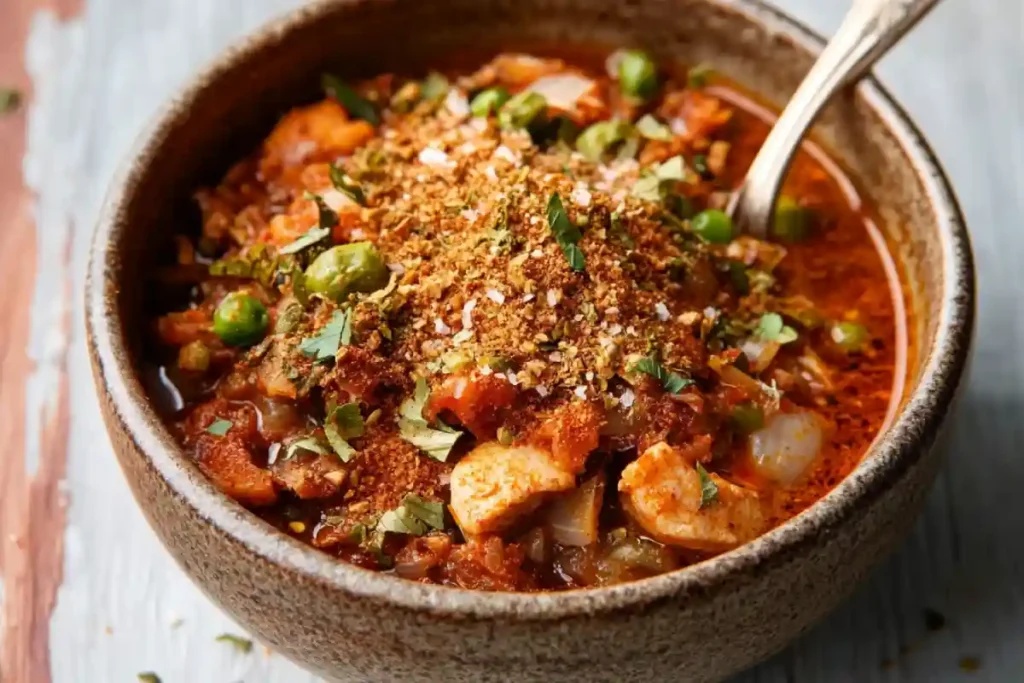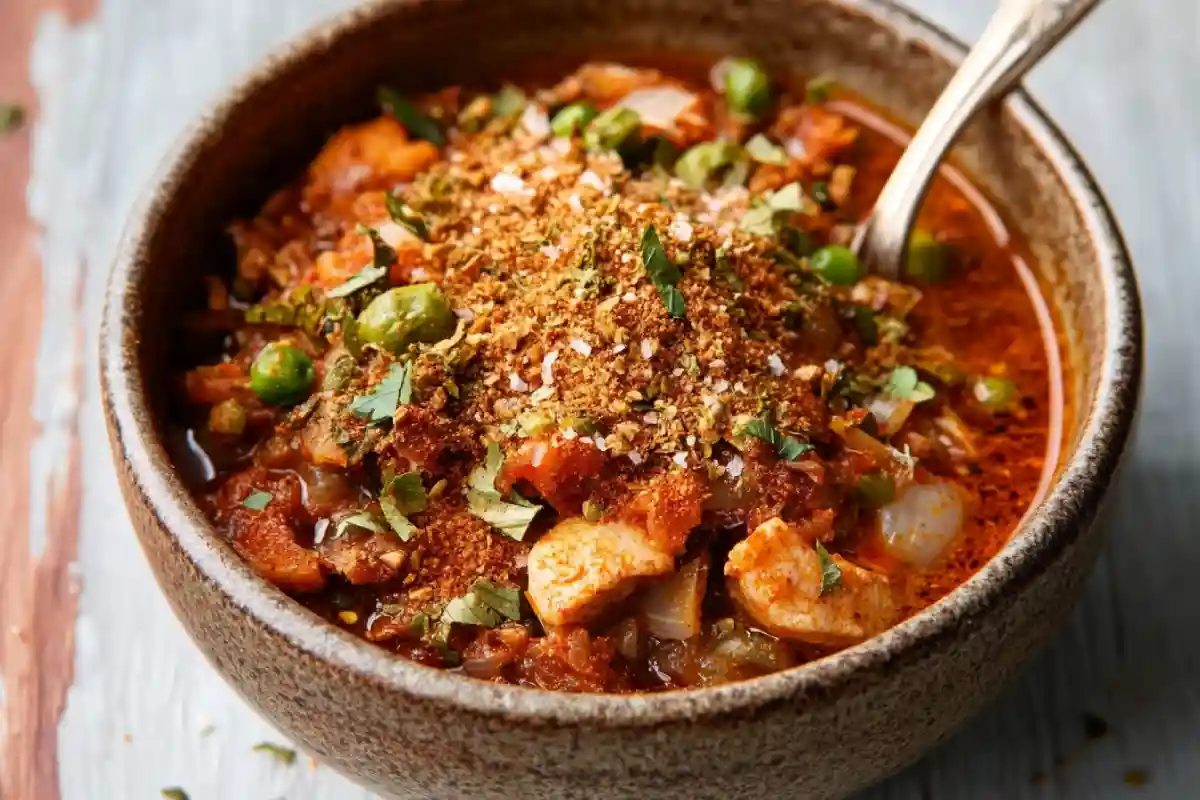
Table of Contents
Nail the cajun seasoning for gumbo once and every pot sings. After blind-tasting five store blends and three homemade ratios, I settled on a 4-2-1 mix of smoked paprika, garlic powder, and cayenne—with white pepper for back-of-throat heat—ready to whisk together from pantry staples in under two minutes.
What Is Cajun Seasoning?
When talking about cajun seasoning for gumbo, it’s essential to first understand what Cajun seasoning really is. This flavorful spice blend is deeply rooted in Louisiana’s rural traditions. Although many people often confuse it with Creole seasoning, the two have distinct origins and uses. While Creole cuisine developed in the city of New Orleans, Cajun flavor emerged from the countryside. Naturally, this led to bold, rustic spice combinations that bring hearty flavor to comfort dishes like gumbo.
Cajun seasoning for gumbo typically includes a variety of spices, which come together to create its signature profile. Although the exact mix can vary from brand to brand, most blends will include:
- Paprika – Adds a smoky and slightly sweet base
- Garlic powder and onion powder – Bring savory depth
- Cayenne pepper – Offers heat and excitement
- Black or white pepper – Balances the flavor profile
- Dried herbs like oregano and thyme – Layer in earthiness
In some cases, turmeric or celery salt may also appear, depending on the recipe. These ingredients contribute not only to flavor but also to the visual richness of your gumbo.
If you’re curious about how these spices came together historically, check out this deep dive into Cajun seasoning from SPICEography. It provides historical context and explains the health benefits of individual components like paprika and garlic.
Moreover, understanding the roots of this seasoning helps you appreciate why it’s used so generously in dishes like gumbo. If you’re exploring the difference between Cajun and Creole recipes, this article on Cajun gumbo vs. Creole gumbo is a great internal guide from Flavivo Recipes that breaks it down clearly.
By starting with a firm grasp of what goes into cajun seasoning for gumbo, you’ll be better equipped to layer in flavor and create meals that reflect authentic Southern tradition.
The Role of Seasoning in Gumbo
To fully understand the importance of cajun seasoning for gumbo, we need to look at gumbo itself. This Louisiana-born dish isn’t just a stew—it’s a symphony of flavors where every note counts. Seasoning is what binds it all together. Without the right balance of spices, even the most carefully crafted gumbo can fall flat. That’s why cajun seasoning for gumbo is more than just a mix—it’s the backbone of the dish.
From the first step in gumbo-making, seasoning plays a role. First, it’s layered into the roux, which forms the base. Then, it’s folded into the broth as it simmers. Finally, it’s adjusted to taste just before serving. Because of this, every stage becomes an opportunity to build flavor.
You may be wondering why seasoning is so vital. Here’s why:
- Builds flavor depth from the base up
- Enhances the taste of meats, seafood, and vegetables
- Balances spicy, savory, and earthy notes
- Brings authenticity to every bite
Moreover, gumbo is known for its slow-cooked richness. But seasoning ensures that richness doesn’t become heaviness. It lifts the dish with vibrant spices that speak to Cajun roots. That’s what sets authentic gumbo apart from just a bowl of soup.
If you’re aiming to make truly memorable gumbo, you’ll want to explore both flavor and tradition. You can dive into more regional tips and flavor-building methods in this guide to the best gumbo in New Orleans—a must-read if you’re chasing authentic results.
Best Cajun Seasoning for Gumbo – Store-Bought vs Homemade
Choosing the best cajun seasoning for gumbo can be tricky, especially with so many blends on the market. However, understanding the differences between store-bought and homemade versions helps you make an informed—and flavorful—decision.
Store-bought Cajun blends are incredibly convenient. In fact, they’re perfect when you’re in a hurry or just starting to explore Southern cooking. On the other hand, homemade blends offer control and flexibility, which many home cooks find essential. They also allow you to tweak salt, heat, and herb levels based on your personal preferences.
🛒 Popular Store-Bought Cajun Seasoning Brands
Several brands are known for their quality Cajun blends. Although not all are identical, many include the essential ingredients used in traditional gumbo.
Here are some of the top-rated brands:
| Brand | Features | Flavor Profile |
|---|---|---|
| Tony Chachere’s | Well-balanced, classic Cajun blend | Medium heat, salty |
| Slap Ya Mama | All-natural, MSG-free | Spicier, bold |
| Louisiana Fish Fry | Includes garlic, paprika, onion powder | Mild, smooth |
| Zatarain’s | Widely available, slightly smoky | Balanced, earthy |
✨ Tip: Always check the label for sodium levels. Some blends can be quite salty.
🧂 Why Make Your Own Cajun Seasoning?
Although store-bought is convenient, making your own cajun seasoning for gumbo gives you complete control. This is especially helpful if you’re cooking for dietary needs or just want a more authentic flavor.
Benefits of homemade seasoning:
- Adjustable heat level
- Lower sodium content
- Freshness and flavor control
- No fillers or preservatives
Homemade seasoning also gives you the freedom to experiment. You can incorporate unique touches, such as smoked paprika or lemon zest, to personalize your gumbo even more.
If you’re interested in exploring more traditional Louisiana meals, this curated list of Louisiana dishes and recipes offers excellent inspiration for deepening your regional cooking knowledge.
Ultimately, whether you go for store-bought or mix your own, the key is consistency. Great gumbo starts with a seasoning blend that complements all the rich, savory layers in the dish.
DIY Cajun Seasoning Recipe for Gumbo
While store-bought blends are handy, nothing beats the aroma and satisfaction of mixing your own cajun seasoning for gumbo. Not only does homemade seasoning allow you to control the ingredients, but it also helps you avoid additives and excess salt that are often found in commercial options.
Most importantly, it brings freshness to your gumbo that pre-packaged blends simply can’t match. Additionally, creating your own spice mix is surprisingly simple and takes just minutes.
Here’s a basic recipe to get you started:
🔥 Basic Homemade Cajun Seasoning Recipe
| Ingredient | Amount | Flavor Contribution |
|---|---|---|
| Paprika (smoked or sweet) | 2 tablespoons | Base flavor, adds color |
| Garlic powder | 1 tablespoon | Earthy, deep flavor |
| Onion powder | 1 tablespoon | Savory and aromatic |
| Dried oregano | 1 teaspoon | Herbal depth |
| Dried thyme | 1 teaspoon | Slight minty, woodsy balance |
| Cayenne pepper | ½ teaspoon | Adds heat and intensity |
| Black pepper | 1 teaspoon | Mild heat, balances cayenne |
| White pepper | ½ teaspoon | Subtle, sharp finish |
| Salt (optional) | 1 teaspoon | Enhances overall flavor |
📝 Tip: You can adjust the cayenne for more or less heat. Start small—you can always add more later!
🛠️ Steps to Make It:
- Combine all spices in a bowl.
- Mix thoroughly with a spoon or whisk.
- Store in an airtight container for up to 6 months.
- Shake before each use to redistribute ingredients evenly.
Not only is this blend ideal for gumbo, but it also works well for grilled meats, roasted vegetables, and even fries. Because of its bold yet balanced flavor, it’s a great all-purpose seasoning.
Using homemade cajun seasoning for gumbo means you’ll always know what’s in your food—and that’s a win for both flavor and health.
Frequently Asked Questions
What are the Cajun seasonings in gumbo?
Cajun seasonings in gumbo typically include a balanced blend of paprika, garlic powder, onion powder, cayenne pepper, black pepper, and dried herbs like thyme and oregano. These ingredients work together to bring heat, depth, and a rich earthy flavor to the dish. When used properly, cajun seasoning for gumbo enhances every layer of the recipe, from the roux to the simmering stock, creating the bold flavor that gumbo is known for.
What is Cajun seasoning made of?
Cajun seasoning is a bold spice mix created from ingredients such as paprika, garlic and onion powder, cayenne pepper, black pepper, and dried herbs. Some blends may also include white pepper, celery seed, or even mustard powder for added complexity. When tailored for gumbo, this seasoning is designed to complement the savory, slow-cooked nature of the dish. Ultimately, cajun seasoning for gumbo is about achieving the right balance of heat, salt, and savory undertones.
How do I make my gumbo more flavorful?
To make your gumbo more flavorful, it’s important to build depth from the beginning. Start by carefully browning your roux, then season in layers throughout the cooking process. Use fresh ingredients and allow your gumbo to simmer long enough for flavors to fully develop. Adding your cajun seasoning for gumbo at different stages—early in the cooking, mid-simmer, and just before serving—helps lock in flavor and makes the final dish truly stand out.
What is the difference between Creole and Cajun seasoning for gumbo?
The main difference between Creole and Cajun seasoning for gumbo lies in their spice profiles and complexity. Creole seasoning tends to be more herb-focused, often including basil, parsley, and bay leaf, making it slightly milder and more aromatic. In contrast, cajun seasoning for gumbo is typically spicier and more rustic, relying on a stronger presence of peppers and garlic. Although both can be used in gumbo, Cajun seasoning delivers a more traditional Louisiana heat and depth that many cooks prefer for authentic flavor.
Conclusion
As you’ve seen throughout this guide, mastering cajun seasoning for gumbo goes far beyond simply tossing spices into a pot. It’s about understanding flavor, respecting tradition, and building your dish layer by layer. While there are many spice blends available, the most flavorful gumbo comes from seasoning with intention—whether you’re using a trusted store-bought mix or creating your own custom blend.
Moreover, gumbo is more than a recipe. It’s a celebration of culture, history, and home cooking. That’s why choosing the right cajun seasoning for gumbo makes such a meaningful difference. When the right spices meet fresh ingredients and patient technique, the result is a deeply comforting meal that brings people together.
So whether you’re simmering a seafood gumbo on a Sunday afternoon or experimenting with a vegetarian twist, remember to taste as you go, adjust with care, and let your seasoning shine. Because at the heart of every great gumbo is the flavor—and the heart—you put into it.

